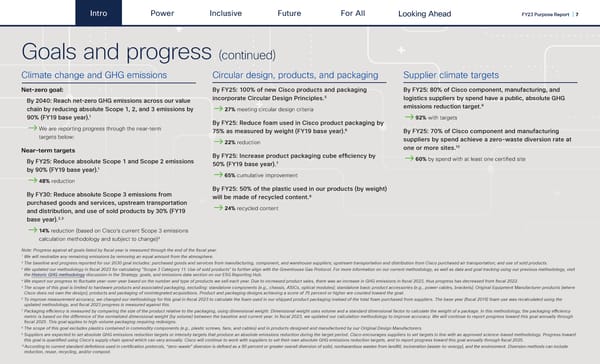Intro Power Inclusive Future For All FY23 Purpose Report | 7 Looking Ahead Goals and progress (continued) Climate change and GHG emissions Circular design, products, and packaging Supplier climate targets Net-zero goal: By FY25: 100% of new Cisco products and packaging By FY25: 80% of Cisco component, manufacturing, and 5 By 2040: Reach net-zero GHG emissions across our value incorporate Circular Design Principles. logistics suppliers by spend have a public, absolute GHG 9 chain by reducing absolute Scope 1, 2, and 3 emissions by 27% meeting circular design criteria emissions reduction target. 1 90% (FY19 base year). By FY25: Reduce foam used in Cisco product packaging by 92% with targets We are reporting progress through the near-term 6 75% as measured by weight (FY19 base year). By FY25: 70% of Cisco component and manufacturing targets below: 22% reduction suppliers by spend achieve a zero-waste diversion rate at 10 Near-term targets one or more sites. By FY25: Reduce absolute Scope 1 and Scope 2 emissions By FY25: Increase product packaging cube ef昀椀ciency by 60% by spend with at least one certi昀椀ed site 7 50% (FY19 base year). 1 by 90% (FY19 base year). 65% cumulative improvement 48% reduction By FY30: Reduce absolute Scope 3 emissions from By FY25: 50% of the plastic used in our products (by weight) will be made of recycled content.8 purchased goods and services, upstream transportation 24% recycled content and distribution, and use of sold products by 30% (FY19 2,3 base year). 14% reduction (based on Cisco’s current Scope 3 emissions 4 calculation methodology and subject to change) Note: Progress against all goals listed by 昀椀scal year is measured through the end of the 昀椀scal year. 1 We will neutralize any remaining emissions by removing an equal amount from the atmosphere. 2 The baseline and progress reported for our 2030 goal includes: purchased goods and services from manufacturing, component, and warehouse suppliers; upstream transportation and distribution from Cisco purchased air transportation; and use of sold products. 3 We updated our methodology in 昀椀scal 2023 for calculating "Scope 3 Category 11: Use of sold products" to further align with the Greenhouse Gas Protocol. For more information on our current methodology, as well as data and goal tracking using our previous methodology, visit the Historic GHG methodology discussion in the Strategy, goals, and emissions data section on our ESG Reporting Hub. 4 We expect our progress to 昀氀uctuate year-over-year based on the number and type of products we sell each year. Due to increased product sales, there was an increase in GHG emissions in 昀椀scal 2023, thus progress has decreased from 昀椀scal 2022. 5 The scope of this goal is limited to hardware products and associated packaging, excluding: standalone components (e.g., chassis, ASICs, optical modules); standalone basic product accessories (e.g., power cables, brackets); Original Equipment Manufacturer products (where Cisco does not own the design); products and packaging of nonintegrated acquisitions. Product and packaging designs achieving a score of 75 percent or higher are counted toward the goal. 6 To improve measurement accuracy, we changed our methodology for this goal in 昀椀scal 2023 to calculate the foam used in our shipped product packaging instead of the total foam purchased from suppliers. The base year (昀椀scal 2019) foam use was recalculated using the updated methodology, and 昀椀scal 2023 progress is measured against this. 7 Packaging e昀케ciency is measured by comparing the size of the product relative to the packaging, using dimensional weight. Dimensional weight uses volume and a standard dimensional factor to calculate the weight of a package. In this methodology, the packaging e昀케ciency metric is based on the di昀昀erence of the normalized dimensional weight (by volume) between the baseline and current year. In 昀椀scal 2023, we updated our calculation methodology to improve accuracy. We will continue to report progress toward this goal annually through 昀椀scal 2025. This goal applies to high-volume packaging requiring redesigns. 8 The scope of this goal excludes plastics contained in commodity components (e.g., plastic screws, fans, and cables) and in products designed and manufactured by our Original Design Manufacturers. 9 Suppliers are expected to set absolute GHG emissions reduction targets or intensity targets that produce an absolute emissions reduction during the target period. Cisco encourages suppliers to set targets in line with an approved science-based methodology. Progress toward this goal is quanti昀椀ed using Cisco’s supply chain spend which can vary annually. Cisco will continue to work with suppliers to set their own absolute GHG emissions reduction targets, and to report progress toward this goal annually through 昀椀scal 2025. 10 According to current standard de昀椀nitions used in certi昀椀cation protocols, “zero-waste” diversion is de昀椀ned as a 90 percent or greater overall diversion of solid, nonhazardous wastes from land昀椀ll, incineration (waste-to-energy), and the environment. Diversion methods can include reduction, reuse, recycling, and/or compost.
 Cisco FY23 Purpose Report Page 7 Page 9
Cisco FY23 Purpose Report Page 7 Page 9